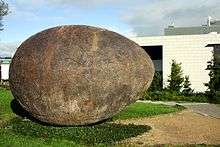Rachel Joynt
Rachel Joynt (born 1966 in County Kerry) is an Irish sculptor who has created some prominent Irish public art. She graduated from the National College of Art and Design in Dublin in 1989 with a degree in sculpture.
Her father, Dick Joynt, was also a sculptor. Rachel Joynt is preoccupied by the historical texture of place and in her work she often seems to expose or memorialize the past as a substrate of the present. Her commissions include People's Island (1988) in which brass footprints and bird feet criss-cross a well-traversed pedestrian island near Dublin's O'Connell Bridge. She collaborated with Remco de Fouw to make Perpetual Motion (1995), a large sphere with road markings which stands on the Naas dual carriageway and featured as a visual shorthand for leaving Dublin in The Apology, a Guinness advert. She made the 900 underlit glass cobblestones which were installed in early 2005 along the edge of Dublin's River Liffey; many of these cobblestones contain bronze or silver fish.
Works in collections and on display

- People's Island (1988) on the pedestrian island south of O'Connell Bridge, Dublin
- A pavement piece depicting Viking crafts, outside Christ Church cathedral, Dublin.
- Solas na Glasrai (The grocers' light) corner of Moore Street and Parnell Street, Dublin.
- A brass light standard hung with casts of fish, fruit and vegetables
- Perpetual Motion (1995) (with Remco deFouw) Naas bypass, County Kildare.
- A marble seat with inset bronze book at the Clare library headquarters in Ennis.
- Noah's Egg (2004) University College Dublin Veterinary School, Belfield, Dublin
- A series of underlit glass cobblestones along the Liffey campshires (2005).
- Mothership Sculpture at the coastline in Glasthule, Dublin
References
- Judith Hill (1998), Irish Public Sculpture. Dublin: Four Courts Press. ISBN 1-85182-274-7.
- Short biography linked to this page about a charity artpack